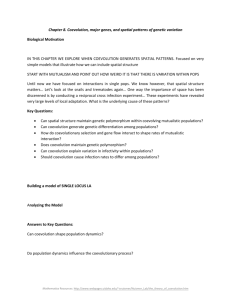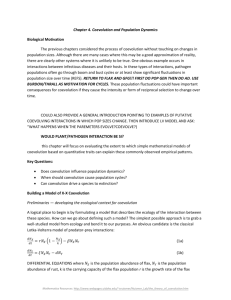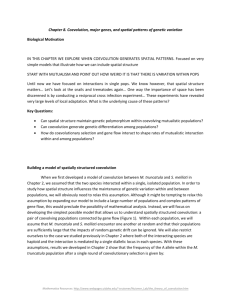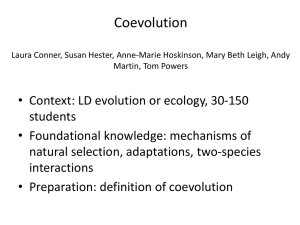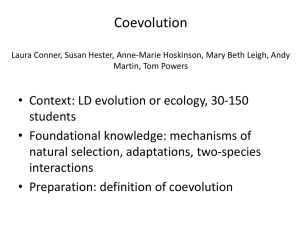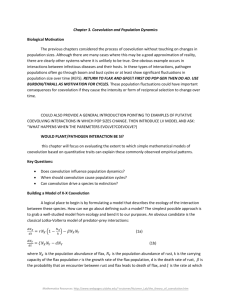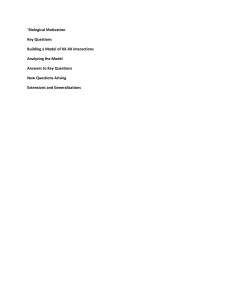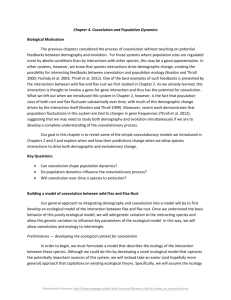Chapter 8. Coevolution, major genes, and spatial patterns of genetic
advertisement
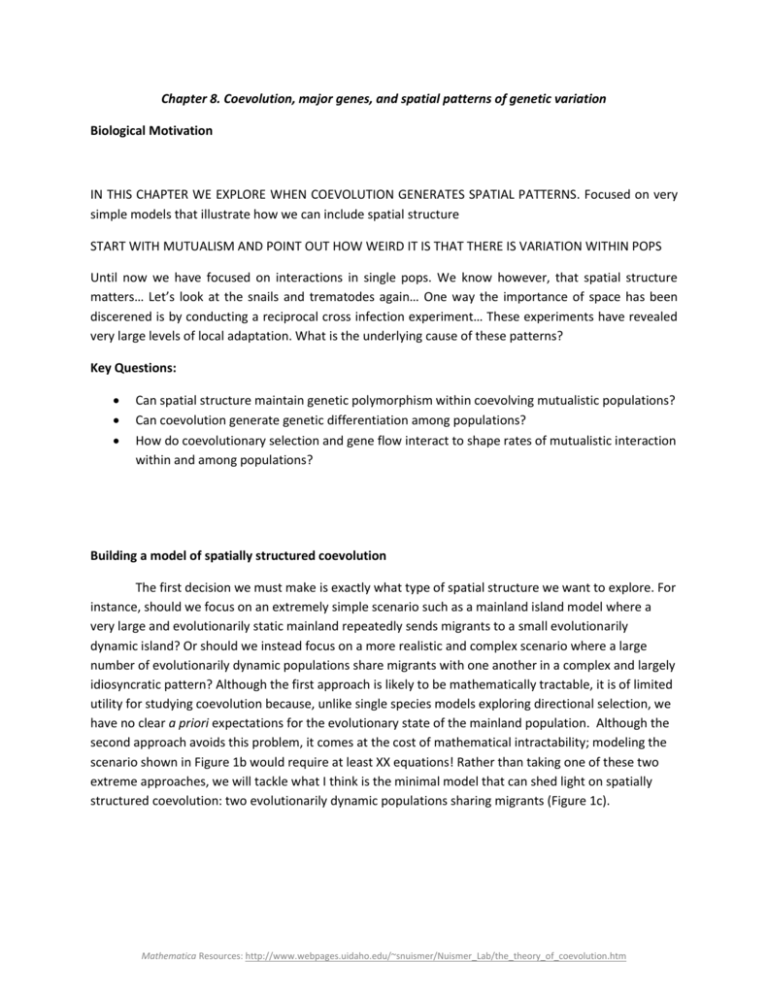
Chapter 8. Coevolution, major genes, and spatial patterns of genetic variation Biological Motivation IN THIS CHAPTER WE EXPLORE WHEN COEVOLUTION GENERATES SPATIAL PATTERNS. Focused on very simple models that illustrate how we can include spatial structure START WITH MUTUALISM AND POINT OUT HOW WEIRD IT IS THAT THERE IS VARIATION WITHIN POPS Until now we have focused on interactions in single pops. We know however, that spatial structure matters… Let’s look at the snails and trematodes again… One way the importance of space has been discerened is by conducting a reciprocal cross infection experiment… These experiments have revealed very large levels of local adaptation. What is the underlying cause of these patterns? Key Questions: Can spatial structure maintain genetic polymorphism within coevolving mutualistic populations? Can coevolution generate genetic differentiation among populations? How do coevolutionary selection and gene flow interact to shape rates of mutualistic interaction within and among populations? Building a model of spatially structured coevolution The first decision we must make is exactly what type of spatial structure we want to explore. For instance, should we focus on an extremely simple scenario such as a mainland island model where a very large and evolutionarily static mainland repeatedly sends migrants to a small evolutionarily dynamic island? Or should we instead focus on a more realistic and complex scenario where a large number of evolutionarily dynamic populations share migrants with one another in a complex and largely idiosyncratic pattern? Although the first approach is likely to be mathematically tractable, it is of limited utility for studying coevolution because, unlike single species models exploring directional selection, we have no clear a priori expectations for the evolutionary state of the mainland population. Although the second approach avoids this problem, it comes at the cost of mathematical intractability; modeling the scenario shown in Figure 1b would require at least XX equations! Rather than taking one of these two extreme approaches, we will tackle what I think is the minimal model that can shed light on spatially structured coevolution: two evolutionarily dynamic populations sharing migrants (Figure 1c). Mathematica Resources: http://www.webpages.uidaho.edu/~snuismer/Nuismer_Lab/the_theory_of_coevolution.htm as we begin to develop a model of spatially structured coevolution between M. truncatula and S. meliloti, we need to first decide just how we In Chapter 2, we developed a model for coevolution between two interacting species mediated by a single diallelic haploid locus. Our results revealed that, in general, the allele frequencies of the A and B alleles after a single episode of coevolutionary selection are given by: ′ 𝑝𝑋,𝑖 = ′ 𝑝𝑌,𝑖 = 𝑝𝑋,𝑖 𝑊𝑋,𝐴,𝑖 ̅ 𝑋,𝑖 𝑊 𝑝𝑌,𝑖 𝑊𝑌,𝐵,𝑖 ̅ 𝑌,𝑖 𝑊 where 𝑝𝑋 is the frequency of the A allele in species X and 𝑝𝑌 is the frequency of the B allele in species Y. If we let 𝑝𝑖′′ = Now that we have expressions for the expected fitness of the various genotypes, we can use these to predict how coevolution will change allele frequencies in the two species. Specifically, substituting (9) into (3) and replacing the general interaction matrix entries 𝛼𝑖,𝑗 with the values appropriate for the matching alleles model shown in Figure 1, yields the following expressions for coevolutionary change in the frequency of M. truncatula and S. meliloti A and B alleles: ∆𝑝𝑋 = −𝑠𝑋 𝑝𝑋 𝑞𝑋 (1−2𝑝𝑌 ) ̅𝑋 𝑊 (10a) ∆𝑝𝑌 = −𝑠𝑌 𝑝𝑌 𝑞𝑌 (1−2𝑝𝑋 ) ̅𝑌 𝑊 (10b) where 𝑞𝑋 = (1 − 𝑝𝑋 ) and 𝑞𝑌 = (1 − 𝑝𝑌 ). These expressions for evolutionary change are almost identical to those describing antagonistic coevolution mediated by a matching alleles model (i.e., Eq. 6), differing only in the sign of the equation predicting evolutionary change in the “host” individual — in this case, the plant, M. truncatula. Analyzing the Model Answers to Key Questions: 2 Can spatial structure maintain genetic polymorphism within coevolving mutualistic populations? Can coevolution generate genetic differentiation among populations? How do coevolutionary selection and gene flow interact to shape rates of mutualistic interaction within and among populations? New Questions Arising: Do similar results hold for other forms of ecological interaction? How would our results change if the environment were heterogeneous? What is the role of random genetic drift? In the next three sections, we will generalize our simple model in ways that allow us to answer these questions. Generalizations Generalization 1: Alternative forms of ecological interaction Generalization 2: Heterogeneous environments and selection mosaics Generalization 3: Random genetic drift Conclusions and Synthesis 3 References Abrams, P. A. 2001. Modelling the adaptive dynamics of traits involved in inter- and intraspecific interactions: An assessment of three methods. Ecology Letters 4:166-175. Aviles, J. M., J. R. Vikan, F. Fossoy, A. Antonov, A. Moksnes, E. Roskaft, J. A. Shykoff, A. P. Moller, and B. G. Stokke. 2012. Egg phenotype matching by cuckoos in relation to discrimination by hosts and climatic conditions. Proceedings of the Royal Society B-Biological Sciences 279:1967-1976. Best, A., A. White, and M. Boots. 2009. The Implications of Coevolutionary Dynamics to Host-Parasite Interactions. American Naturalist 173:779-791. Burdon, J. J., and P. H. Thrall. 1999. Spatial and temporal patterns in coevolving plant and pathogen associations. American Naturalist 153:S15-S33. Burdon, J. J., and P. H. Thrall. 2000. Coevolution at multiple spatial scales: Linum marginale- Melampsora lini - from the individual to the species. Evolutionary Ecology 14:261-281. Carval, D., and R. Ferriere. 2010. A UNIFIED MODEL FOR THE COEVOLUTION OF RESISTANCE, TOLERANCE, AND VIRULENCE. EVOLUTION 64:2988-3009. Dieckmann, U., and M. Doebeli. 1999. On the origin of species by sympatric speciation. Nature 400:354357. Dieckmann, U., and R. Law. 1996. The dynamical theory of coevolution: A derivation from stochastic ecological processes. Journal of Mathematical Biology 34:579-612. Frank, S. A. 1991. ECOLOGICAL AND GENETIC MODELS OF HOST PATHOGEN COEVOLUTION. Heredity 67:73-83. Gavrilets, S. 2004. Fitness landscapes and the origin of species. Princeton University Press, Princeton. Jones, E. I., R. Ferriere, and J. L. Bronstein. 2009. Eco-Evolutionary Dynamics of Mutualists and Exploiters. AMERICAN NATURALIST 174:780-794. Kiester, A. R., R. Lande, and D. W. Schemske. 1984. MODELS OF COEVOLUTION AND SPECIATION IN PLANTS AND THEIR POLLINATORS. AMERICAN NATURALIST 124:220-243. Kirkpatrick, M., and V. Ravigne. 2002. Speciation by natural and sexual selection: Models and experiments. American Naturalist 159:S22-S35. Kondrashov, A. S., and F. A. Kondrashov. 1999. Interactions among quantitative traits in the course of sympatric speciation. Nature 400:351-354. Kopp, M., and S. Gavrilets. 2006. Multilocus genetics and the coevolution of quantitative traits. Evolution 60:1321-1336. Luijckx, P., H. Fienberg, D. Duneau, and D. Ebert. 2013. A Matching-Allele Model Explains Host Resistance to Parasites. Current Biology 23:1085-1088. Mode, C. J. 1958. A MATHEMATICAL-MODEL FOR THE CO-EVOLUTION OF OBLIGATE PARASITES AND THEIR HOSTS. EVOLUTION 12:158-165. Nuismer, S. L., M. Doebeli, and D. Browning. 2005. The coevolutionary dynamics of antagonistic interactions mediated by quantitative traits with evolving variances. Evolution 59:2073-2082. Nuismer, S. L., and M. Kirkpatrick. 2003. Gene flow and the coevolution of parasite range. Evolution 57:746-754. Seger, J. 1988. Dynamics of some simple host-parasite models with more than two genotypes in each species. Phil. Trans. R. Soc. Lond. B. 319:541-555. Thrall, P. H., A.-L. Laine, M. Ravensdale, A. Nemri, P. N. Dodds, L. G. Barrett, and J. J. Burdon. 2012. Rapid genetic change underpins antagonistic coevolution in a natural host-pathogen metapopulation. Ecology Letters 15:425-435. Tian, D., M. B. Traw, J. Q. Chen, M. Kreitman, and J. Bergelson. 2003. Fitness costs of R-gene-mediated resistance in Arabidopsis thaliana. Nature 423:74-77. 4 Yoshida, T., L. E. Jones, S. P. Ellner, G. F. Fussmann, and N. G. Hairston, Jr. 2003. Rapid evolution drives ecological dynamics in a predator-prey system. Nature 424:303-306. 5 Figure Legends Figure 1. Population dynamics predicted by the Lotka-Volterra model for three different rust death rates, d. In all cases, the dashed line indicates rust population size and the solid line indicates flax population size. Parameters held constant across panels were 𝛼 = .1, 𝛽 = .03, 𝜉 = .01, 𝑟 = .1, and 𝑘 = 100. Rust death rates were: A) 𝑑 = .005 B) 𝑑 = .081, and C) 𝑑 = .1. Figure 2. Population sizes and allele frequencies for the gene-for-gene model over time for three different rust death rates, d. In all cases, dashed lines indicate rust population size or frequency of the virulent allele and solid lines indicate flax population size or frequency of the resistant allele. Parameters held constant across panels were 𝛽 = .003, 𝜉 = .001, 𝑟 = .1, and 𝑘 = 100. Rust death rates were: A) 𝑑 = .005 B) 𝑑 = .081, and C) 𝑑 = .1. Figure 3. Population sizes and allele frequencies for the gene-for-gene model with costs of resistance and virulence over time for three different costs of virulence. In all cases, dashed lines indicate rust population size or frequency of the virulent allele and solid lines indicate flax population size or frequency of the resistant allele. Parameters held constant across panels were 𝛽 = .003, 𝜉 = .001, 𝑟𝐴 = .05, 𝑟𝑎 = .09, 𝑑𝑏 = .01 and 𝑘 = 100. Death rates of the virulent rust allele were: A) 𝑑𝐵 = .005 B) 𝑑𝐵 = .081, and C) 𝑑𝐵 = .1. Figure 4. Population dynamics and allele frequencies for the matching alleles model over time for three different P. ramosa death rates, d. In all cases, dashed lines indicate P. ramosa population size or frequency of the B allele and solid lines indicate D. magna population size or frequency of the A allele. Parameters held constant across panels were 𝛽 = .003, 𝜉 = .001, 𝑟 = .1, and 𝑘 = 100. Rust death rates were: A) 𝑑 = .005 B) 𝑑 = .081, and C) 𝑑 = .1. Figure 5. Population sizes and phenotypes over time for the phenotype matching model and two different cuckoo death rates, d. In all cases, dashed lines indicate cuckoo population size or egg color phenotype and solid lines indicate warbler population size or egg color phenotype. Parameters held constant across panels were 𝛽 = .006, 𝜉 = .005, 𝑟 = .05, 𝑘 = 100, and the mutation rates of the two species 𝜇𝑋 = .02 and 𝜇𝑌 = .02. Rust death rates were: A) 𝑑 = .06 and B) 𝑑 = .03. 6 Table 1. Summary of stability conditions and ecological dynamics Condition Implications for stability Equilibrium (3c) unstable; 𝑑 > 𝑘𝛼𝜉 Equilibrium (3b) stable Equilibrium (3c) stable; 𝑑 < 𝑘𝛼𝜉 Equilibrium (3b) unstable Equilibrium (3c) stable and 4𝑘𝛼𝜉 oscillatory; 𝑑 < 𝑘𝛼𝜉 ( ) 𝑟 + 4𝑘𝛼𝜉 Equilibrium (3b) unstable 7 Biological consequences Extinction of Rust. Flax at carrying capacity Coexistence of Flax and Rust Coexistence of Flax and Rust. Transient cycles likely. Table 2. Equilibria corresponding to parasite extinction. Because we assume carrying the virulent allele is costly, 𝑑𝐵 > 𝑑𝑏 . Equilibrium 𝑁𝑋 = 𝑘, 𝑁𝑌 = 0, 𝑝𝑅 = 0, 𝑝𝑉 = 0 𝑁𝑋 = 𝑘, 𝑁𝑌 = 0, 𝑝𝑅 = 0, 𝑝𝑉 = 1 𝑁𝑋 = 𝑘, 𝑁𝑌 = 0, 𝑝𝑅 = 1, 𝑝𝑉 = 0 𝑁𝑋 = 𝑘, 𝑁𝑌 = 0, 𝑝𝑅 = 1, 𝑝𝑉 = 1 𝑁𝑋 = 𝑘, 𝑁𝑌 = 0, 𝑝𝑅 = 1 − (𝑑𝑏 ⁄𝑘𝜉 ), 𝑝𝑉 = 0 Conditions for instability 𝑑𝑏 < 𝑘𝜉 Always unstable 𝑑𝐵 − 𝑑𝑏 < 𝑘𝜉 𝑘𝜉 + 𝑑𝑏 < 𝑑𝐵 𝑜𝑟 𝑑𝐵 < 𝑘𝜉 𝑑𝐵 < 𝑘𝜉 8
